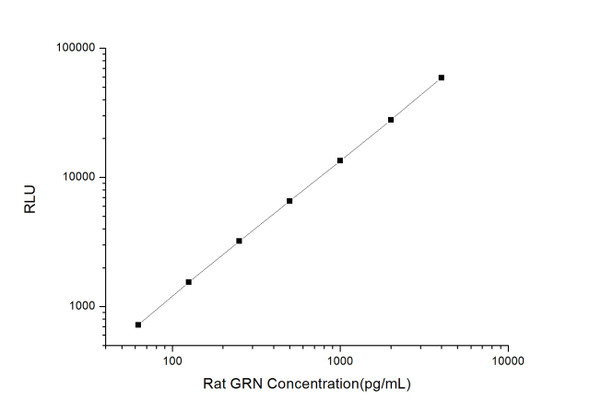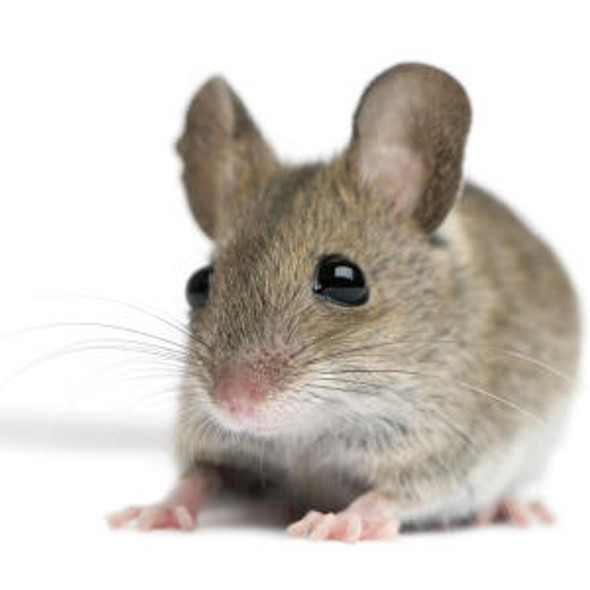Mouse Cell Signalling ELISA Kits 2
Mouse GRN (Granulin) CLIA Kit (MOES00309)
- SKU:
- MOES00309
- Product Type:
- ELISA Kit
- ELISA Type:
- CLIA Kit
- Size:
- 96 Assays
- Sensitivity:
- 0.19ng/mL
- Range:
- 0.31-20ng/mL
- ELISA Type:
- Sandwich
- Reactivity:
- Mouse
- Sample Type:
- Serum, plasma and other biological fluids
Description
| Assay type: | Sandwich |
| Format: | 96T |
| Assay time: | 4.5h |
| Reactivity: | Mouse |
| Detection method: | Chemiluminescence |
| Detection range: | 0.31-20 ng/mL |
| Sensitivity: | 0.19 ng/mL |
| Sample volume: | 100µL |
| Sample type: | Serum, plasma and other biological fluids |
| Repeatability: | CV < 15% |
| Specificity: | This kit recognizes Mouse GRN in samples. No significant cross-reactivity or interference between Mouse GRN and analogues was observed. |
This kit uses Sandwich-CLIA as the method. The micro CLIA plate provided in this kit has been pre-coated with an antibody specific to Mouse GRN. Standards or samples are added to the appropriate micro CLIA plate wells and combined with the specific antibody. Then a biotinylated detection antibody specific for Mouse GRN and Avidin-Horseradish Peroxidase (HRP) conjugate are added to each micro plate well successively and incubated. Free components are washed away. The substrate solution is added to each well. Only those wells that contain Mouse GRN, biotinylated detection antibody and Avidin-HRP conjugate will appear fluorescence. The Relative light unit (RLU) value is measured spectrophotometrically by the Chemiluminescence immunoassay analyzer. The RLU value is positively associated with the concentration of Mouse GRN. The concentration of Mouse GRN in the samples can be calculated by comparing the RLU of the samples to the standard curve.
| UniProt Protein Function: | GRN: Granulins have possible cytokine-like activity. They may play a role in inflammation, wound repair, and tissue remodeling. Defects in GRN are the cause of ubiquitin-positive frontotemporal dementia (UP-FTD); also known as tau- negative frontotemporal dementia linked to chromosome 17. Frontotemporal dementia (FTD) is the second most common cause of dementia in people under the age of 65 years. It is an autosomal dominant neurodegenerative disease. Defects in GRN are the cause of neuronal ceroid lipofuscinosis type 11 (CLN11). A form of neuronal ceroid lipofuscinosis characterized by rapidly progressive visual loss due to retinal dystrophy, seizures, cerebellar ataxia, and cerebellar atrophy. Cognitive decline may also occur. Neuronal ceroid lipofuscinoses are progressive neurodegenerative, lysosomal storage diseases characterized by intracellular accumulation of autofluorescent liposomal material. Belongs to the granulin family. 2 isoforms of the human protein are produced by alternative splicing. |
| UniProt Protein Details: | Protein type:Secreted, signal peptide; Secreted Cellular Component: extracellular space; cell surface; mitochondrion; intracellular membrane-bound organelle; extracellular region Molecular Function:cytokine activity Biological Process: male mating behavior; synaptic vesicle endocytosis; blastocyst hatching; response to estradiol stimulus; embryo implantation; positive regulation of epithelial cell proliferation |
| UniProt Code: | P28798 |
| NCBI GenInfo Identifier: | 585216 |
| NCBI Gene ID: | 14824 |
| NCBI Accession: | P28798. 2 |
| UniProt Related Accession: | P28798 |
| Molecular Weight: | 63,458 Da |
| NCBI Full Name: | Granulins |
| NCBI Synonym Full Names: | granulin |
| NCBI Official Symbol: | Grn |
| NCBI Official Synonym Symbols: | Pgrn; epithelin |
| NCBI Protein Information: | granulins; PEPI; PCDGF; progranulin; acrogranulin; proepithelin; PC cell-derived growth factor |
| UniProt Protein Name: | Granulins |
| UniProt Synonym Protein Names: | PC cell-derived growth factor; PCDGF; Proepithelin; PEPI |
| Protein Family: | Granulin |
| UniProt Gene Name: | Grn |
| UniProt Entry Name: | GRN_MOUSE |
As the RLU values of the standard curve may vary according to the conditions of the actual assay performance (e. g. operator, pipetting technique, washing technique or temperature effects), the operator should establish a standard curve for each test. Typical standard curve and data is provided below for reference only.
| Concentration (ng/mL) | RLU | Average | Corrected |
| 20 | 31194 36770 | 33982 | 33950 |
| 10 | 11396 13544 | 12470 | 12438 |
| 5 | 5424 5076 | 5250 | 5218 |
| 2.5 | 2326 2722 | 2524 | 2492 |
| 1.25 | 1431 1335 | 1383 | 1351 |
| 0.63 | 910 824 | 867 | 835 |
| 0.31 | 591 655 | 623 | 591 |
| 0 | 31 33 | 32 | -- |
Precision
Intra-assay Precision (Precision within an assay): 3 samples with low, mid range and high level Mouse GRN were tested 20 times on one plate, respectively.
Inter-assay Precision (Precision between assays): 3 samples with low, mid range and high level Mouse GRN were tested on 3 different plates, 20 replicates in each plate.
| Intra-assay Precision | Inter-assay Precision | |||||
| Sample | 1 | 2 | 3 | 1 | 2 | 3 |
| n | 20 | 20 | 20 | 20 | 20 | 20 |
| Mean (ng/mL) | 1.09 | 3.05 | 9.09 | 1.11 | 2.77 | 8.72 |
| Standard deviation | 0.13 | 0.27 | 0.71 | 0.12 | 0.24 | 0.57 |
| C V (%) | 11.93 | 8.85 | 7.81 | 10.81 | 8.66 | 6.54 |
Recovery
The recovery of Mouse GRN spiked at three different levels in samples throughout the range of the assay was evaluated in various matrices.
| Sample Type | Range (%) | Average Recovery (%) |
| Serum (n=5) | 99-111 | 105 |
| EDTA plasma (n=5) | 101-115 | 108 |
| Cell culture media (n=5) | 100-113 | 107 |
Linearity
Samples were spiked with high concentrations of Mouse GRN and diluted with Reference Standard & Sample Diluent to produce samples with values within the range of the assay.
| Serum (n=5) | EDTA plasma (n=5) | Cell culture media (n=5) | ||
| 1:2 | Range (%) | 99-116 | 90-106 | 90-104 |
| Average (%) | 106 | 97 | 96 | |
| 1:4 | Range (%) | 99-113 | 90-104 | 94-107 |
| Average (%) | 107 | 96 | 101 | |
| 1:8 | Range (%) | 99-113 | 84-96 | 85-97 |
| Average (%) | 107 | 90 | 90 | |
| 1:16 | Range (%) | 86-99 | 102-116 | 95-108 |
| Average (%) | 92 | 110 | 101 |
An unopened kit can be stored at 4°C for 1 month. If the kit is not used within 1 month, store the items separately according to the following conditions once the kit is received.
| Item | Specifications | Storage |
| Micro CLIA Plate(Dismountable) | 8 wells ×12 strips | -20°C, 6 months |
| Reference Standard | 2 vials | |
| Concentrated Biotinylated Detection Ab (100×) | 1 vial, 120 µL | |
| Concentrated HRP Conjugate (100×) | 1 vial, 120 µL | -20°C(shading light), 6 months |
| Reference Standard & Sample Diluent | 1 vial, 20 mL | 4°C, 6 months |
| Biotinylated Detection Ab Diluent | 1 vial, 14 mL | |
| HRP Conjugate Diluent | 1 vial, 14 mL | |
| Concentrated Wash Buffer (25×) | 1 vial, 30 mL | |
| Substrate Reagent A | 1 vial, 5 mL | 4°C (shading light) |
| Substrate Reagent B | 1 vial, 5 mL | 4°C (shading light) |
| Plate Sealer | 5 pieces | |
| Product Description | 1 copy | |
| Certificate of Analysis | 1 copy |
- Set standard, test sample and control (zero) wells on the pre-coated plate and record theirpositions. It is recommended to measure each standard and sample in duplicate. Note: addall solutions to the bottom of the plate wells while avoiding contact with the well walls. Ensuresolutions do not foam when adding to the wells.
- Aliquot 100µl of standard solutions into the standard wells.
- Add 100µl of Sample / Standard dilution buffer into the control (zero) well.
- Add 100µl of properly diluted sample (serum, plasma, tissue homogenates and otherbiological fluids. ) into test sample wells.
- Cover the plate with the sealer provided in the kit and incubate for 90 min at 37°C.
- Aspirate the liquid from each well, do not wash. Immediately add 100µL of BiotinylatedDetection Ab working solution to each well. Cover the plate with a plate seal and gently mix. Incubate for 1 hour at 37°C.
- Aspirate or decant the solution from the plate and add 350µL of wash buffer to each welland incubate for 1-2 minutes at room temperature. Aspirate the solution from each well andclap the plate on absorbent filter paper to dry. Repeat this process 3 times. Note: a microplatewasher can be used in this step and other wash steps.
- Add 100µL of HRP Conjugate working solution to each well. Cover with a plate seal andincubate for 30 min at 37°C.
- Aspirate or decant the solution from each well. Repeat the wash process for five times asconducted in step 7.
- Add 100µL of Substrate mixture solution to each well. Cover with a new plate seal andincubate for no more than 5 min at 37°C. Protect the plate from light.
- Determine the RLU value of each well immediately.






